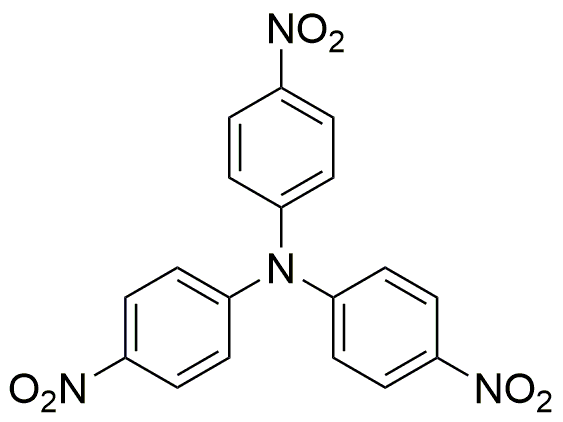Tris(4-nitrophenyl)amine is widely utilized in research focused on:
- Hematology: This compound serves as a vital reagent in blood analysis, aiding in the identification of various blood components and conditions, which is crucial for accurate diagnostics.
- Histology: It is employed in tissue staining processes, enhancing the visibility of cellular structures under a microscope, thus facilitating better examination and diagnosis of tissue samples.
- Analytical Chemistry: Tris(4-nitrophenyl)amine is used in developing colorimetric assays, allowing researchers to quantify specific analytes in complex mixtures with high sensitivity.
- Pharmaceutical Research: This compound can be utilized in drug formulation studies, particularly in assessing the stability and efficacy of pharmaceutical compounds, ensuring quality control in drug development.
- Environmental Monitoring: It plays a role in detecting pollutants in water and soil samples, helping researchers and industry professionals monitor environmental health and compliance with regulations.
General Information
Properties
Safety and Regulations
Applications
Tris(4-nitrophenyl)amine is widely utilized in research focused on:
- Hematology: This compound serves as a vital reagent in blood analysis, aiding in the identification of various blood components and conditions, which is crucial for accurate diagnostics.
- Histology: It is employed in tissue staining processes, enhancing the visibility of cellular structures under a microscope, thus facilitating better examination and diagnosis of tissue samples.
- Analytical Chemistry: Tris(4-nitrophenyl)amine is used in developing colorimetric assays, allowing researchers to quantify specific analytes in complex mixtures with high sensitivity.
- Pharmaceutical Research: This compound can be utilized in drug formulation studies, particularly in assessing the stability and efficacy of pharmaceutical compounds, ensuring quality control in drug development.
- Environmental Monitoring: It plays a role in detecting pollutants in water and soil samples, helping researchers and industry professionals monitor environmental health and compliance with regulations.
Documents
Safety Data Sheets (SDS)
The SDS provides comprehensive safety information on handling, storage, and disposal of the product.
Product Specification (PS)
The PS provides a comprehensive breakdown of the product’s properties, including chemical composition, physical state, purity, and storage requirements. It also details acceptable quality ranges and the product's intended applications.
Certificates of Analysis (COA)
Search for Certificates of Analysis (COA) by entering the products Lot Number. Lot and Batch Numbers can be found on a product’s label following the words ‘Lot’ or ‘Batch’.
*Catalog Number
*Lot Number
Certificates Of Origin (COO)
This COO confirms the country where the product was manufactured, and also details the materials and components used in it and whether it is derived from natural, synthetic, or other specific sources. This certificate may be required for customs, trade, and regulatory compliance.
*Catalog Number
*Lot Number
Safety Data Sheets (SDS)
The SDS provides comprehensive safety information on handling, storage, and disposal of the product.
DownloadProduct Specification (PS)
The PS provides a comprehensive breakdown of the product’s properties, including chemical composition, physical state, purity, and storage requirements. It also details acceptable quality ranges and the product's intended applications.
DownloadCertificates of Analysis (COA)
Search for Certificates of Analysis (COA) by entering the products Lot Number. Lot and Batch Numbers can be found on a product’s label following the words ‘Lot’ or ‘Batch’.
*Catalog Number
*Lot Number
Certificates Of Origin (COO)
This COO confirms the country where the product was manufactured, and also details the materials and components used in it and whether it is derived from natural, synthetic, or other specific sources. This certificate may be required for customs, trade, and regulatory compliance.


